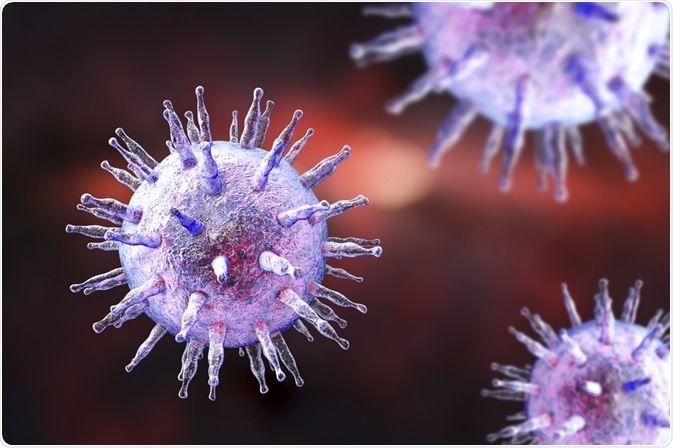Mononucleosis is an infectious disease, caused by a virus. Commonly known as the kissing disease or as mono, it is transmitted through saliva. Most often, only teenagers and adults show a full onset of symptoms, whereas children tend to have few or no symptoms.

Image Credit: Kateryna Kon/Shutterstock.com
Causes and occurrence
Most cases of mononucleosis are caused by the Epstein-Barr virus, but other viruses can also cause it. Epstein-Barr virus has a relatively long incubation period of around four to six weeks, which is when symptoms appear. For children, this may be shorter. The Epstein-Barr virus is primarily replicated in the white blood cells.
The highest rates of infectious mononucleosis occur in people who are 10-19 years old and are drastically lower in those younger than 10 or older than 30. Because of this, outbreaks are more common in settings with many young adults, such as military bases and colleges. In these populations, the rates of infectious mononucleosis can be around 11-48 cases per one thousand people.
Symptoms of mononucleosis
The symptoms include extreme fatigue, fever, sore throat, and aches in the body and the head. The most common include a sore throat, which affects 98% of patients The aches may be extended to swollen lymph nodes in the neck and armpits and a rash. Less common symptoms include a swollen liver, spleen, or both.
Some of the symptoms, such as fever and sore throat, can become less serious within a couple of weeks, whereas the fatigue, enlarged lymph nodes, and swollen spleen may last for longer. In some cases, the symptoms of mononucleosis may persist for longer than half a year.
Infectious mononucleosis can be difficult to diagnose in some cases. Tests are not always accurate early on in the infection, but diagnosis can usually be done based on symptoms alone, especially in those who are 10-30 years old when many are infected.
However, different types of viruses can be responsible for mononucleosis, which means that laboratory tests are needed in those with abnormal cases of infectious mononucleosis. Some of the symptoms of those with infectious mononucleosis include high levels of white blood cells or lymphocytes, atypical lymphocytes, low levels of neutrophils and platelets, and abnormal functioning of the liver.
The general guidelines for these laboratory tests follow Hoagland’s criteria: 50% lymphocytes and 10% atypical lymphocytes, accompanied by fever, sore throat, and a positive serological test. While these are strict, they are typically used for research purposes and infectious mononucleosis can be present with only some of these.

Image Credit: BlurryMe/Shutterstock.com
Transmission of mononucleosis
The disease is quite common, with around 1 in 4 teenagers and young adults likely to develop infectious mononucleosis. Despite this, mononucleosis is not as contagious as other viruses, such as the common cold.
Mononucleosis is transmitted through saliva. The amount of saliva that is needed to transmit mononucleosis is variable – it can be transmitted through kissing, by exposure to coughs or sneezes, or by sharing glasses or cutlery with someone who has mononucleosis. Mononucleosis can also spread through blood and semen, such as through blood transfusions, organ transplants, and sexual contact.
Treatment and long-term effects of mononucleosis
There is no vaccine in existence against mononucleosis, which means that preventative measures focusing on changes in behavior are more effective. This includes not kissing, sharing food, or sharing personal items with someone who has mononucleosis. Furthermore, Epstein-Barr virus can remain in the saliva for several months after the infection clears. This means care needs to be taken even after symptoms disappear.
The uncomfortable symptoms of mononucleosis can be relieved. It’s important to stay hydrated by drinking a lot of fluids and getting a lot of rest. Some symptoms can also be relieved by taking medications against fever and pains.
If symptoms get severe, the spleen or liver can become swollen. This may cause complications, such as rupturing. Because of this possibility, contact sports should be avoided during the infection. Rupturing is associated with a sharp and sudden pain in the upper abdomen. This may require surgery. Swelling can also affect the liver. In this case, complications can include mild liver inflammations such as hepatitis and jaundice, which is a yellowing of the skin.
Some complications are rarer. Mononucleosis can, on occasion, cause issues in the cardiovascular system, including anemia, heart problems, and swollen tonsils which can cause difficulty breathing. Other issues can include thrombocytopenia, which is a low count of platelets in the blood, and issues with the nervous system, such as meningitis, encephalitis, and Guillain-Barre syndrome.
Sources
- Mayo Clinic. 2018. Mononucleosis - Symptoms and Causes. [online] Available at: <https://www.mayoclinic.org/diseases-conditions/mononucleosis/symptoms-causes/syc-20350328> [Accessed 7 September 2020].
- Centre for Disease Control and Prevention. 2020. Epstein-Barr Virus And Infectious Mononucleosis. [online] Available at: <https://www.cdc.gov/epstein-barr/about-mono.html> [Accessed 7 September 2020].
- Ebell, M., 2004. Epstein-Barr Virus Infectious Mononucleosis. American Family Physician, 70(7), pp. 1279-1287.